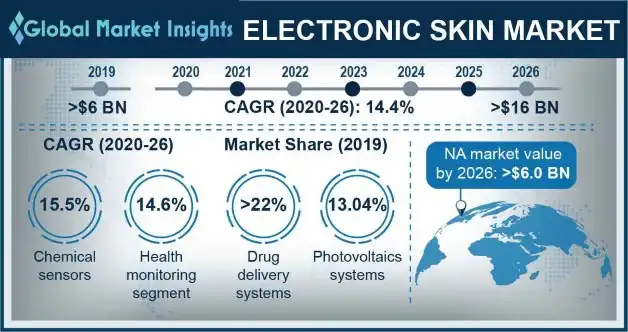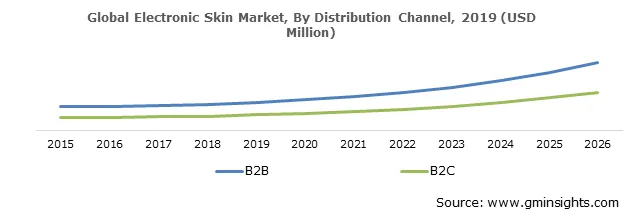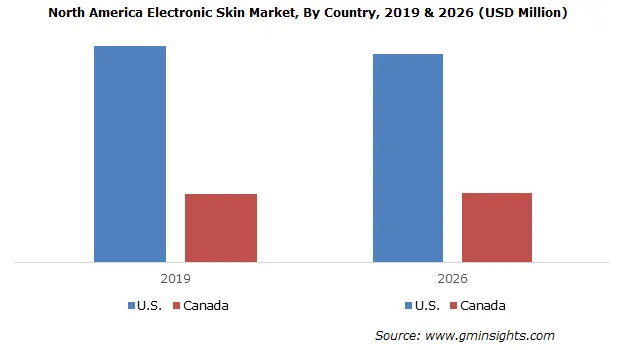


Electronic Skin Market
Get a free sample of this report
Your inquiry has been received. Our team will reach out to you with the required details via email. To ensure that you don't miss their response, kindly remember to check your spam folder as well!
Form submitted successfully!
Error submitting form. Please try again.

Request Sectional Data
Your inquiry has been received. Our team will reach out to you with the required details via email. To ensure that you don't miss their response, kindly remember to check your spam folder as well!
Form submitted successfully!
Error submitting form. Please try again.
Electronic Skin Market size exceeded USD 6 Billion in 2019 and is predicted to grow at over 14.4% CAGR from 2020 to 2026.

Electronic skin is a type of artificial smart skin that consists of varied sensors stacked along the same surface. Electronic skin is most prominently used in robotics to provide a sense of touch. Such applications had helped the electronic skin industry to expand its product portfolio in the healthcare sector for tracking health and fitness related to various ailments.
| Report Attribute | Details |
|---|---|
| Base Year: | 2019 |
| Electronic Skin Market size in 2019: | USD 6,494.69 Million |
| Forecast Period: | 2020 to 2026 |
| Forecast Period 2023 - 2032 CAGR: | 14.4 |
| 2023 Value Projection: | USD 16,017.81 Million |
| Historical Data for: | 2015 to 2019 |
| No of Pages: | 180 |
| Tables, Charts & Figures: | 390 |
| Segments Covered: | Product, Component, Sensor Type, Application, Distribution Channel |
| Growth Drivers: |
|
| Pitfalls Challenges: |
|
Electronic skin is being utilized in industries including robotics and healthcare owing to its properties such as self-healing, self-powered and stretching ability. Electronic skin is most frequently utilized in electronic skin patches for health monitoring, drug delivery, as well as therapeutic uses.
The growing demand and the acceptance of electronic skin due to its potential benefits will propel the industry growth. Electronic skin and skin patches are being utilized for a wide array of application such as monitoring diabetes, cardiovascular disorders, pregnancy, detecting abnormalities in the brain and others. In addition, the increasing demand of electronic skin components in the wearable electronics is also expected to boost the demand of the electronic skin market.
Also, increase in funding by various companies for developing technologically advanced electronic skin products has also supplemented the market growth. For instance, in 2013 MC10 received a funding of around $8 million for the development of flexible health sensors. Medtronic also had funded MC10 in 2012 with $10 million for developing nearly invisible and conformal electronics. Thus, such increase in funding and investments by many companies will also propel the market growth.
Electronic patches held a significant market revenue of USD 4,278.66 million in 2019. This is mainly due to increasing applications of electronic skin patches such as cardiovascular monitoring and diabetes management via CGM (continuous glucose monitoring). Electronic skin patches are also being utilized for fitness tracking, fever monitoring and fertility monitoring which is expected to garner a healthy growth rate during the analysis period for the market.
Photovoltaics systems accounted for 13.04% share of the global market in 2019 and is expected to witness a similar trend during the forecast period.
The adoption of photovoltaics systems in skin patches and sensors are increasing due to limitations of traditional patches. One major limitation of traditional skin patches is the need for charging the device, which negatively impacted health monitoring for various individuals. Thus, the introduction of miniature low-cost photovoltaics systems will help in creating lucrative opportunities in the electronic skin market.
Electrophysiological sensors emerged as the largest segment in terms of sensor type in the industry and was valued at USD 2,129.67 million in 2019. The major market share is due to increased adoption of electrophysiological sensors in monitoring diseases such as chronic diseases as well as restoration therapy of patients who might have underwent trauma. Therefore, owing to the benefits of sensors the industry is expected to garner a higher CAGR in the forecast period.
Health monitoring segment dominated the global market in 2019 and is expected to grow at a CAGR of 14.6% through 2026.
Health monitoring via electronic skin suit and electronic skin patches are being conducted for various ailments such as diabetes, cardiovascular diseases, pregnancy related concerns, smoking cessation and fever among other ailments. Therefore, owing to wide array of ailments health monitoring covers, the market is anticipated to witness a substantial growth.

B2B segment witnessed a significant growth over the historic period, wherein the revenue of 2016 was USD 3,595.4 million. B2B segment offers various advantages over B2C segment such as new customers with more online habits, instant order fulfilment as well as big order values which correspond to more revenues. Thus, due to aforementioned factors, the market size is expected to grow with a healthy CAGR during the study period.

North America industry is expected to grow at a higher growth rate throughout the forecast period and is projected to exceed USD 6 billion by 2026. The U.S. dominated the global market in 2019 as the country is in forefront of technological innovations. This is due to the presence of strong institutional pillars, financing mechanisms, business dynamism and vibrant innovation ecosystem in the country.
Also, the presence of various electronic skin patches manufacturers in the U.S. will create lucrative opportunities for key market players. Few players operating the U.S. market include VivaLnK, Inc, MC10, Xsensio, Rotex Inc., Chrono Therapeutics and iRhythm Technologies among other manufacturers.
Some of the prominent players operating in the market include:
Development and launch of novel and technologically advanced products for better health monitoring and funding received by major organizations are few strategies adopted by the market players.
Recent industry developments:
Market by Product
Market by Component
Market by Sensor Type
Market by Application
Market by Distribution Channel
The above information is provided for the following regions and countries:
According to this research report by GMI, the health monitoring segment dominated the global market in 2019 and is expected to grow at a CAGR of 14.6% through 2026.
The market size of electronic skin exceeded USD 6 Billion in 2019.
The industry share of electronic skin is predicted to grow at over 14.4% CAGR from 2020 to 2026.
North America market is expected to grow at a higher growth rate throughout the forecast period and is projected to exceed USD 6 billion by 2026.
Some of the prominent market players include MC10, Xsensio, Rotex Inc., Renew Health Limited (Intelesens ltd.), Xenoma Inc., VivaLnK, Inc., Chrono Therapeutics, iRhythm, Holst Centre, Byteflies & Quad Industries, Bloomlife, Dexcom, Insulet Corporation, Feeligreen, Gentag and Abbott Laboratories.